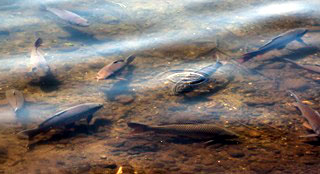by Garet Munger
Bits and pieces of the Eurasian milfoil have been washing up along the shore at Green Lake in greater than usual volumes this spring. This more than normal accumulation is likely the result of carp rooting around in the depths of the lake. Carp feed on the bottom where they uproot and break milfoil pieces, which float to the surface. The bits and pieces are blown around the lake and onto the shore by the winds. This accumulation of pieces of milfoil piling up along the shore is beginning to rot in place.
“Common carp (Cyprinus carpio) thrive in turbid rivers and lakes. They are omnivorous, eating insects, crustaceans, annelids, mollusks, and seeds from weeds and trees. For the most part they grub in the sediments to find food, stirring up sediments and increasing turbidity. Adults will uproot and destroy aquatic vegetation, which may be detrimental to ducks and other fish populations. There are carp in many lakes in the state, and people are encouraged to fish for them. They are not to be put back into any waters of the state. We would like to diminish these populations.” (Washington State Department of Fish and Wildlife species account for Common Carp).

Carp basking in NE Green Lake near paddleboats July 8.
Washington State Department of Fish and Wildlife worked to remove carp from the lake in 2005 using electroshocking techniques. There have been no systematic counts of the carp in the lake since that time. Fishermen and other regular visitors to the lake are convinced that the number of carp in the lake has been increasing over the last couple of years. In spite of encouragement from WDFW to fish for carp, few Green Lake fishermen ever want to have a carp on their line.
A small but energetic group of Friends of Green Lake volunteers worked hard Saturday (July 6) morning raking milfoil out of the lake. More continues to wash up on the shore line as the wind pushes it around. Removal of the accumulated milfoil has good effects for the lake. Getting the milfoil out of the water removes nutrients from the lake that would otherwise contribute to algal growth that has been a problem for the lake.Then there is the effect of the mass of milfoil rotting along the shore. As it rots, it begins to smell of rotten eggs and worse. Not a pleasant effect! More work parties to rake milfoil can be arranged. For more information and to volunteer email Garet Munger at garetpeter@comcast.net. Rakes can be made available.
